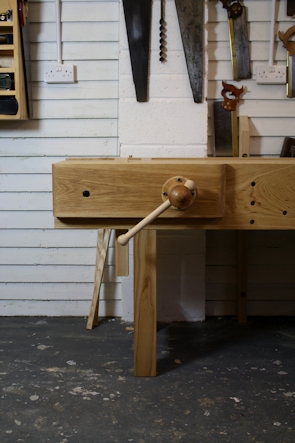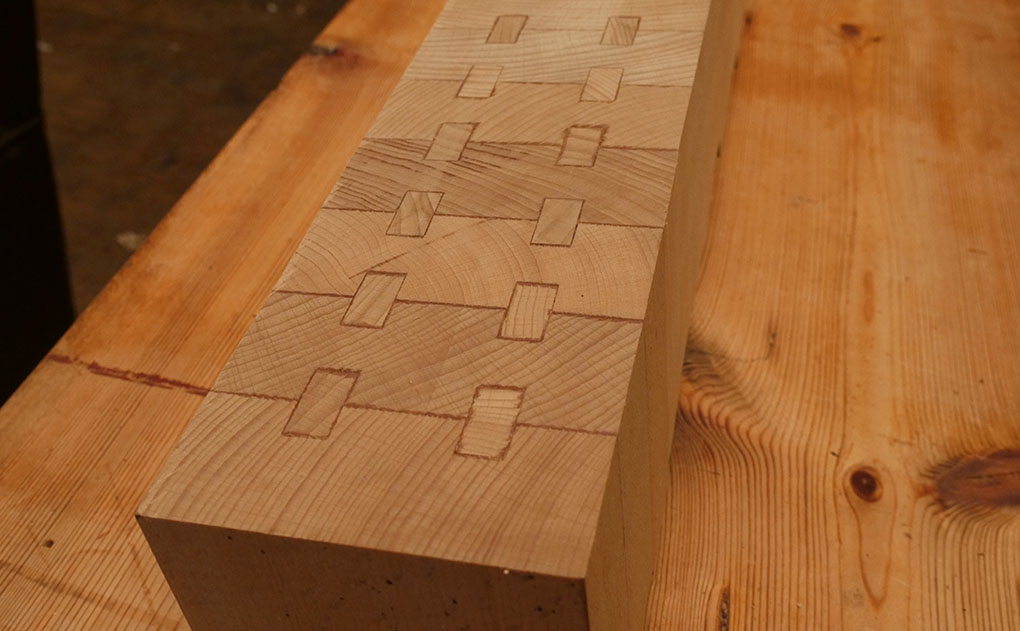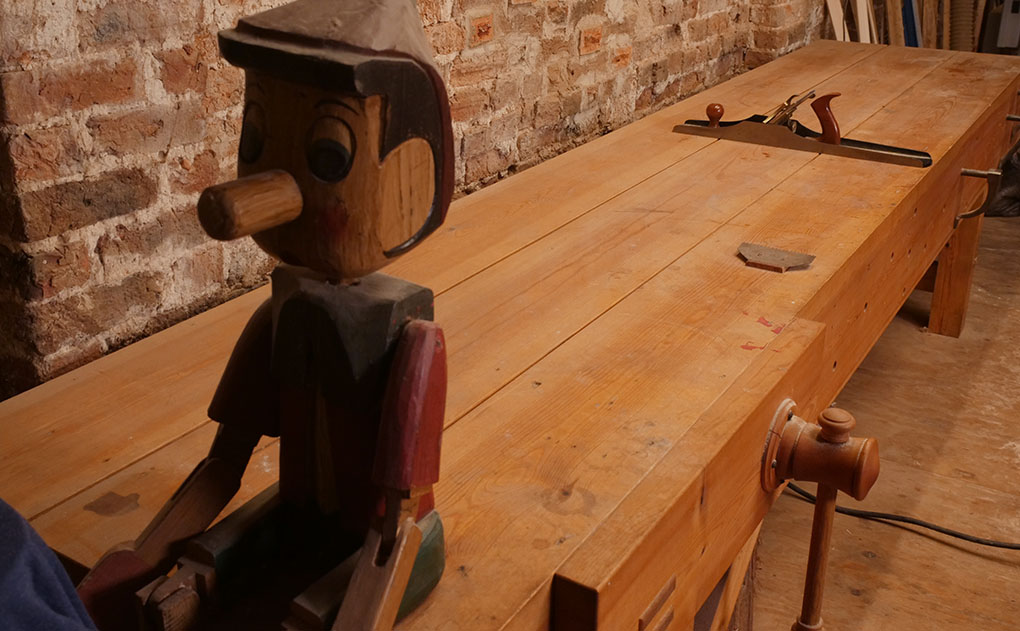Building a Workbench
This is will be the first post of probably hundreds on my new workbench for the hand tool workshop. I’ve taken my Little John bench round there for the time being to allow me to potter and keep busy but it’s surprising how dependable this has become for the main workshop and it’s getting missed. The new hand tool workshop has more space…far more space than what I’m used to and so it’ll be nice to have a longer bench in there and I needed little excuse to build myself one – I’ve been edging to experiment for some time.
 The vast majority of workbenches which I’ve built over recent years have been based more or less on the traditional French design; very simple and robust. But for my first on camera build I felt that it’s really got to be English. I’m incredibly fond of this design and it isn’t all just sentiment. There’s much variation of course but the principles at the heart of the benches built in England back in the Golden age of English furniture making are ones which hold particular relevance to my situation and workshop today. If I could sum it up in one word it would be efficiency. Efficiency of labour, materials and even in the end use for aiding work flow and holding. It’s this efficiency in the design which I would like to bring to light and through using it I feel I can best show some of the ways in which I was first taught to use a workbench.
The vast majority of workbenches which I’ve built over recent years have been based more or less on the traditional French design; very simple and robust. But for my first on camera build I felt that it’s really got to be English. I’m incredibly fond of this design and it isn’t all just sentiment. There’s much variation of course but the principles at the heart of the benches built in England back in the Golden age of English furniture making are ones which hold particular relevance to my situation and workshop today. If I could sum it up in one word it would be efficiency. Efficiency of labour, materials and even in the end use for aiding work flow and holding. It’s this efficiency in the design which I would like to bring to light and through using it I feel I can best show some of the ways in which I was first taught to use a workbench.

It’s also the only historic bench design where the original materials are still very much relevant to what we can obtain today. The more hefty top of a French bench can be made both beautiful and stable by laminating up many thinner strips but without access to any machines that’s not a job I’d look forward to – it would be a real pain! And the large slabs which would have made sense to use back then would be impractical for me to source or use now.
The 2″ boards for my English bench however should be no trouble to find and so the design will be as relevant for me now as it was in its hay day.
 I’ll talk a lot more about the construction methods and usage of this bench as I start bringing my ideas together but I’m aiming to make sure it will suit my situation as best as possible. That will mean a relatively low cost, fast paced build and absolutely no requirement for machines. This will also be a bench that the complete beginner can build and know that they’ll have a solid bench to last them as long as they want.
I’ll talk a lot more about the construction methods and usage of this bench as I start bringing my ideas together but I’m aiming to make sure it will suit my situation as best as possible. That will mean a relatively low cost, fast paced build and absolutely no requirement for machines. This will also be a bench that the complete beginner can build and know that they’ll have a solid bench to last them as long as they want.

![Simple Work Holding For Ploughing Grooves [Without a Tail Vice]](https://www.theenglishwoodworker.com/wp-content/uploads/2022/07/workholding-without-tail-vice-copy.jpg)
![Gluing Up A Workbench Leg [VIDEO]](https://www.theenglishwoodworker.com/wp-content/uploads/2022/06/gluing-up-a-workbench-leg-video.jpg)



I will look forward to following your English Bench build. I built one of the Paul Sellers style benches not long ago and I love it. My bench is set very high by the way although it is difficult to dimension plane wood on it. I could see having one for planing and one for joinery some day.
Stephen,
When you want a lower working height would it be advantageous to build a substantial ‘duck board’ to stand on? Much quicker than making another bench, and if you used pressure treated timber, it could be stored outside.
Just a thought!
John
That’s what I have. It was leftover wood from a garden project. 3 2x8x8’s with doubled up 2x4s as bottom cross members inset 8″ or so at each end. Mine leans up against the wall behind the drill press for those rare occasions when I need it. It could easily be hung up on the back of the building or something if space is tight. Even leaned up against the back of the bench if so desired. Plenty of options for storage including outside. I have another small box that I’ll stand on sometimes for boring or morticing but don’t need it often either.
That is a really good idea. I would have never thought of that! Thanks for the tip!!
I’m so looking forward to this.
Hoping you key in on the wagon vise installation (that seems apparent in the pics).
Looking forward to further posts on this bench Richard.
Although, I am not a fan of an apron myself. (I even recall an old shop-manager saying that aprons encourage ‘bench-lolling’!:)) Putting one on my bench though would deny access to much needed storage under the bench. And I need storage. My shop (17 feet x 9 feet) would fit into your new hand-shop and be lost!
All the best.
JW
Looking forward to this, Richard, and, in particular, how the design fits in with your style of working.
I’m very much looking forward to this build Richard, so thank you for sharing. I’m at a workbench crossroads myself (looking to move from a Scandinavian bench to French or English design) so I will be watching this with rapt attention.
David
I enjoyed this post, Richard, but it does conjure up what I think is a relative question…it is obvious you think highly of traditional English benches, so why, as you stated, have the vast majority of benches that you have built recently been French?
Glad you are back! I love the look of your English Bench – simple and elegant, particularly with your vice. I too can’t wait to follow along with your progress. I also like a taller bench and will stand on a step if I need to be up higher. Jim
Looking forward to the workbench build. May be the one I have been looking to build.
Thanks
Mike O’Brien
Valley Head, AL, USA
I see you have holes in the apron. Are these useful for holdfasts? If so, can a holdfast really hold in a 2″ board? (Or even less if one uses 8/4 lumber and planes it smooth)?
this will be very interesting .looking forward to it.
Sign me up! Looking forward to the build. I’ll be following along and building right behind you!
If you one along the lines of the one in the second picture, you’re going to keep a blacksmith busy for awhile making enough holdfasts. You could do three projects at once on that bench. Looking forward to the build.
Hello Richard, first off all I want to thank you for your blog and your work. I like your vids very much. And I like “english syle” woodworkers.
I´ve build weeks ago a new workbench for my personal style and needs in woodworking. I called it “French Roubo Like Bench”, because it´s for my needs. The bench top is a 20mm mdf top with 20 mm wholes for the festool clamps. (This is maybe a top, where a real handtool woodworker is laughing at me)
The base is in style of a french bench and I´ve took a 100 mm high and 40 mm thick apron on it, flush with the legs. I can do handwork with chisels on the massive legs perfectly.On my blog I posted it.
I´m very interested in your project, build a real kind of english bench, because my opinion is, it is an very interesting an sexy look like bench. But first of all, the wood is affordable and you can get it everywhere. And the building process in my opinion is not so hard then it is on a real french bench. And I think, the top is not so stressy because of the working and twisting wood.
The only thing I would change on the english design is, that i would flush the legs with the apron, like it is on your picture too.
That are the thoughts of a german woodworker about english benches.
I´m on that thing and on your blog in the future,
Andi – Alwaysworkingman